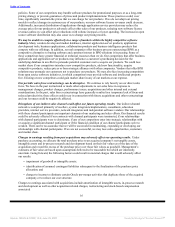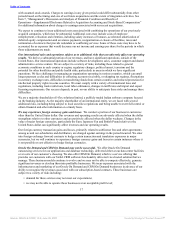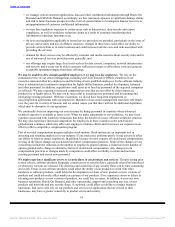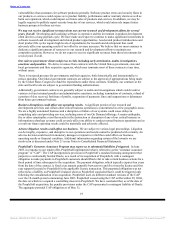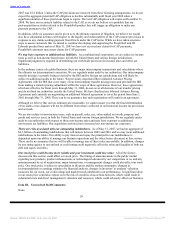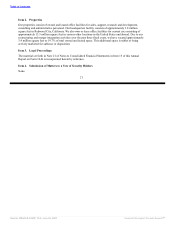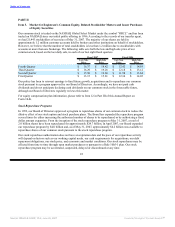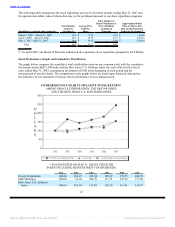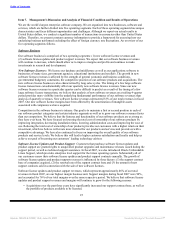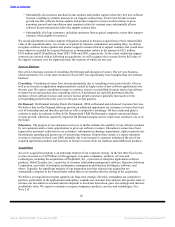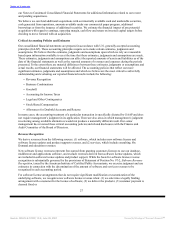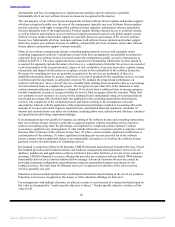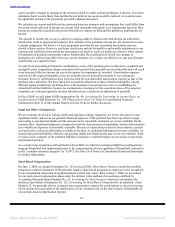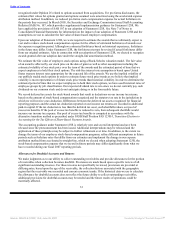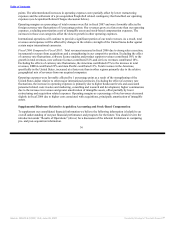Oracle 2006 Annual Report Download - page 30
Download and view the complete annual report
Please find page 30 of the 2006 Oracle annual report below. You can navigate through the pages in the report by either clicking on the pages listed below, or by using the keyword search tool below to find specific information within the annual report.
Table of Contents
• Substantially all customers purchase license updates and product support when they buy new software
licenses, resulting in a further increase in our support contract base. Even if new license revenue
growth was flat, software license updates and product support revenues would continue to grow
assuming renewal and cancellation rates remained relatively constant since substantially all new
software license transactions add to the support contract base.
• Substantially all of our customers, including customers from acquired companies, renew their support
contracts when eligible for renewal.
We record adjustments to reduce support obligations assumed in business acquisitions to their estimated fair
value at the acquisition dates. As a result, as required by business combination accounting rules, we did not
recognize software license updates and product support revenues related to support contracts that would have
been otherwise recorded by acquired businesses as independent entities in the amount of $212 million,
$391 million and $320 million in fiscal 2007, 2006 and 2005, respectively. To the extent underlying support
contracts are renewed with us following an acquisition, we will recognize the revenues for the full value of
the support contracts over the support periods, the majority of which are one year.
Services Business
Our services business consists of consulting, On Demand and education revenues. Our services business,
which represents 21% of our total revenues in fiscal 2007, has significantly lower margins than our software
business.
Consulting: Consulting revenues have increased primarily due to consulting services provided by i-flex as
well as an increase in application implementations created by higher sales of new software applications over
the past year. We expect consulting revenues to continue to grow as consulting revenues tend to lag software
revenues by several quarters since consulting services, if purchased, are typically performed after the
purchase of new software licenses and our new license growth rates have generally increased over the
corresponding period in the prior year over the past several quarters.
On Demand: On Demand includes Oracle On Demand, CRM on Demand and Advanced Customer Services.
We believe that our On Demand offerings provide an additional opportunity for customers to lower their total
cost of ownership and can therefore provide us with a competitive advantage. We have made and plan to
continue to make investments in Oracle On Demand and CRM On Demand to support current and future
revenue growth, which has negatively impacted On Demand margins and we expect may continue to do so in
the future.
Education: The purpose of our education services is to further enhance the usability of our software products
by our customers and to create opportunities to grow our software revenues. Education revenues have been
impacted by personnel reductions in our customers’ information technology departments, tighter controls over
discretionary spending and greater use of outsourcing solutions. Despite these trends, we expect education
revenues to increase in fiscal year 2008, primarily due to an increase in customer training on the use of our
acquired application products and increases in license revenues from our database and middleware products.
Acquisitions
An active acquisition program is an important element of our corporate strategy. In the last three fiscal years,
we have invested over $25 billion, in the aggregate, to acquire companies, products, services and
technologies, including the acquisitions of PeopleSoft, Inc., a provider of enterprise applications software
products; Siebel Systems, Inc., a provider of customer relationship management software; Hyperion Solutions
Corporation, a provider of enterprise performance management and business intelligence software; and
others. Typically, the significant majority of our integration activities related to an acquisition are
substantially complete in the United States within three to six months after the closing of the acquisition.
We believe our acquisition program supports our long-term strategic direction, strengthens our competitive
position, particularly in the applications marketplace, expands our customer base and provides greater scale to
increase our investment in research and development to accelerate innovation, grow our earnings and increase
stockholder value. We expect to continue to acquire companies, products, services and technologies. See
Note 2 of
26
Source: ORACLE CORP, 10-K, June 29, 2007 Powered by Morningstar® Document Research℠


